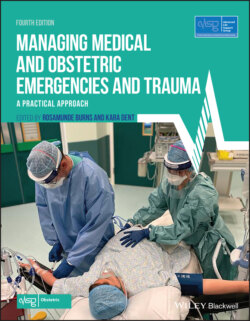Читать книгу Managing Medical and Obstetric Emergencies and Trauma - Группа авторов - Страница 95
Appendix 5.2 Radiology in the pregnant woman
ОглавлениеImaging using ionising radiation is often part of the management of seriously ill patients. Patients and healthcare workers are often concerned that the doses of radiation used may be harmful to the fetus (Table 5A.2). A chest X‐ray confers a minimal amount of radiation to the fetus and is the equivalent of 1 week of background radiation in London. If a chest X‐ray is clinically indicated as a first line investigation in chest pain or breathlessness it should be performed.
Table 5A.2 Safety of different imaging techniques
| Investigation | Radiation dose (mGy) | First trimester | Breastfeeding |
|---|---|---|---|
| Chest X‐ray | <0.01 | Safe | Safe |
| CT head scan* | Safe | Avoid | |
| MRI head scan* | Avoid | Safe | |
| CTPA* | <0.13 | Safe | Avoid |
| V/Q scan | Safe | Avoid | |
| CT abdomen* | Safe | Avoid | |
| Ultrasound | Safe | Safe |
* Express and discard breastmilk for 24 hours if using contrast.
Ultrasound, computed tomography (CT) scans of the head and chest and magnetic resonance imaging (MRI) are safe throughout pregnancy. Gadolinium contrast should be avoided.
For women with suspected pulmonary embolism and a normal chest X‐ray, a lung perfusion scan should be requested in preference to CT pulmonary angiography (CTPA) because the radiation dose to maternal lung and breast tissue is lower.
